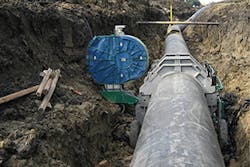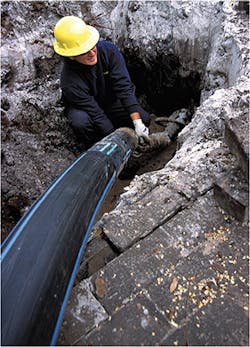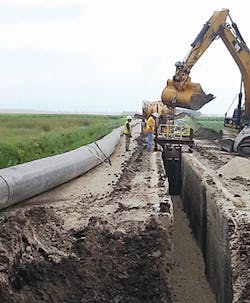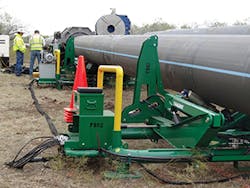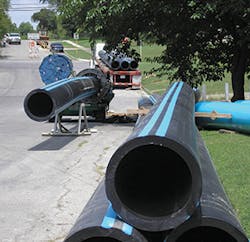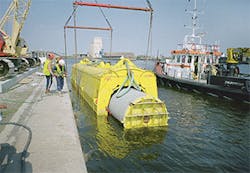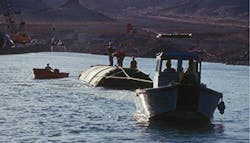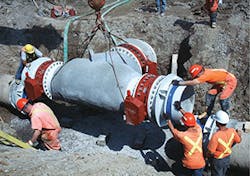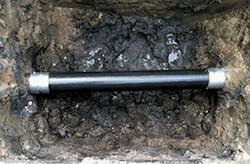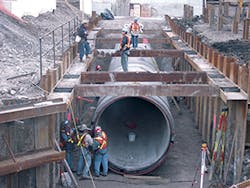Recent American Water Works Association (AWWA) studies conclude that America is currently in an era of pipe replacement, points out Lawyer Jolley, general manager of Performance Pipe, a division of Chevron Phillips Chemical Company.
“With more than one million miles of water piping in the United States, much of which was installed more than 50 years ago, there is a critical need to replace pipe that has reached or is near the end of its useful life,” says Jolley, adding that two of the biggest issues with existing water infrastructure are corrosion and leakage.
Pipe in stone hole
In addressing water infrastructure, “we talk about the old pipe and how the pipe that was made 100 years ago is not the same pipe as we make today,” points out Gregg Horn, vice president in charge of technical services for the Ductile Iron Pipe Research Association (DIPRA). “The metallurgy and manufacturing techniques have improved,” he says. “Today, we do internal pressure loadings as well as external loadings for earth and traffic loadings, and we know how to control erosion.
“One hundred years ago, for example, we didn’t have 18 wheelers, so that pipe was put in the ground without the benefit of that type of engineering. We have asked that pipe to do a heck of a lot that it was never conceived of having to deal with, including inside and outside corrosioncontrol in that era.”
Horn recently pointed out to a group of US mayors gathering for a meeting that while the industry has been focusing on pipe that is going into the ground in the future, “we forget sometimes about the older pipe and the problems it can present. But we’re doing a better job.”
Flint, MI’s lead-in-water crisis sharpened the focus on the aging infrastructure. As water utilities conduct condition assessments and make moves to repair or replace pipe, today’s choices present a number of innovations designed to address the many challenges facing water transmission.
One key area of innovation is in the use of newer materials that provide more cost-effective solutions, Jolley points out.
“High-density polyethylene [HDPE] pipes have been available for 50 years, used extensively in gas distribution, mining, and industrial project applications,” he says. “Today, innovation is coming in the form of utilities that are now taking advantage of the benefits that HDPE pipes provide as a solution to leakage and corrosion in existing aged municipal infrastructure.”
“With the pipe’s leak-tight fusion joints and corrosion resistance, as well as trenchless installation options that HDPE pipes make achievable, HDPE piping has become a more cost-effective solution for utilities overall.”
“Polyethylene physical properties can be adjusted through the design of the polymer architecture,” says Jolley. “This is accomplished through the use of copolymers, specialized catalysts, and resin production technology.”
A new grade of HDPE piping materials described as PE4710 pipe resins were introduced in the AWWA water transmission and distribution standards in 2015, Jolley points out. “PE4710 pipe resins have increased toughness to resist loads and damage, and they are rated to provide a 25% higher pressure rating for the same size pipe without reduction to the pipeline system safety.
“This change in the AWWA standard allows utilities to take advantage of the durability and reliability of HDPE pressure pipes while also making HDPE pipe a more cost-competitive choice,” he adds.
Chevron Phillips Chemical Company is constructing a 1.1-billion-pound bimodal polyethylene reactor on the US Gulf Coast that will be capable of producing PE4710 pipe resins. Startup of the US Gulf Coast petrochemicals project is expected in mid-2017.
The HDPE heat-fused joint has been at the heart of HDPE’s success as a pipeline, notes Jolley. “While mechanically connected joints and mechanical fittings are an important part of any pipeline, the tensile strength and the strain capability of the HDPE fusion joint have led to its reliability and success in applications,” he adds.
Jolly points out that recent advancements in the development of the fusion procedure for HDPE pipes include:
- The addition of polyethylene fusion into ASME BPV section 9, which has been retitled “Welding, Brazing, and Fusing” in recognition of HDPE fusion
- ASTM standard F3124 for the practice of Data Recording of field fusion joints
- The recently approved ASTM standard practice for Operator Qualification
- The ASTM standard test for field fusions called the “Side Bend” tester.
“These procedures—along with existing ASTM standard fusion procedure for HDPE—provide the utility with the confidence to specify the fusion method, including training requirements and quality control procedures,” adds Jolley.
Seismic resistance is another concern regarding water pipe infrastructure. “Analysis of pipeline damage after significant earthquakes has shown that polyethylene pipe provides significant resistance to both transient and permanent ground deformation,” says Jolley. “This was projected to be a benefit of HDPE pipeline due to the large strain tolerance of both the pipes and the heat-fused joint.
“Both polyethylene and the HDPE heat-fused joints can withstand short-term strains of 8% and a design allowance of 3% for long-term strain.”
Jolley points out recent studies of earthquakes have demonstrated that the tensile strain resistance of HDPE pipes prevented pipeline damage from seismic activity.
One of the original methods of installing HDPE pipes was to slip-line, or insert the pipe inside an existing pipeline, says Jolley. Pipe bursting involves sending blades to cut through the older host pipe and inserting an HDPE pipeline in its place that is of a larger diameter.
“The smooth flow characteristics of the interior of the HDPE pipe often made it possible to match or increase the flow rate with the reduced diameter,” he says. “Today’s technology allows larger-diameter HDPE pipes to replace smaller-diameter aging pipelines utilizing pipe bursting technology.”
Weaver Project was a 30-inch x 17 DIPS main water line-to-plant installation.
In one instance, the city of Austin, TX, needed to increase the water capacity to its burgeoning population. The city used pipe bursting to replace 6-inch cast iron pipes with 10-inch HDPE pipes, “which significantly reduced the cost of the installation and the disruption to the neighborhoods that would be caused by traditional open cut burial methods,” points out Jolley.
Pipe bursting is also designed to be a more cost-effective alternative to abandonment of Asbestos-Cement (AC) pipelines, says Jolley.
“The Water Research Foundation published a report in 2015, the ‘Environmental Impact of Asbestos Cement Pipe Renewal Technologies,’ which in part assessed pipe bursting using PE4710 HDPE pipes,” he says.
“The report found that there was no negative impact on the air quality, that the method did not adversely impact soil environment, and had no negative impact on the water quality,” he adds. “The method and use of PE4710 HDPE pipes offers utilities a cost-effective and environmentally secure method to replace AC pipelines, many of which have reached the end of their designed service life.”
HDPE pipes and the HDPE fusion joint have been used “very successfully” in directional drilling applications, says Jolley.
“The strength and flexibility of HDPE pipes allow the pipes to be deflected to a tighter bend radius than the drill rod. This provides additional confidence to the utility that the pipe won’t see damage from over-deflection,” he says. “Additionally, HDPE pipes can be tapped on a bend with no concerns of cracking, providing further assurance to the utility regarding the integrity of its pipeline.”
A San Antonio Water System wellfield in 2012
The Performance Pipe company was recently recognized by the Plastics Pipe Institute for its “Project of the Year,” a competition that highlights the installation and use of plastic piping products in unique ways through scale, scope, or innovation.
The project, “Regional Carrizo Water Project, San Antonio Water System” (SAWS), involved the installation of 122,149 feet of various-sized pipe for the purpose of transporting 13 million gallons per day (MGD) of water from a well field to an integration point in northeast San Antonio, where it enters the SAWS distribution system.
The project was designed to assist in diversifying San Antonio’s water supply, reducing dependence on the existing Edwards Aquifer supplies, as well as to provide water to help meet San Antonio’s short- and mid-term water needs, beginning in late 2013.
While the project was initially specified for steel pipe and ductile iron, concerns over the corrosive nature of the groundwater led to the choice of HDPE. More than 11 million pounds of material and more than 23 miles of large-diameter polyethylene pipeline were used in the project.
While corrosive pipes in Flint, MI, turned the spotlight on pipe materials and related factors, “it’s a situation that is obviously not limited to Flint—it’s all over the place,” notes Tony Radoszewski, president of the Plastics Pipe Institute.
“Cities with origins to the late 1800s are all in a similar situation as Flint,” he adds. “I recently spoke with a water supervisor in a city out West who told me that even though hers is a relatively new city, its roots go back to the 1880s, and there is lead pipe in 30% of its current water system.”
A 24-inch DIPS 11 bluestripe line from a directional drill in San Antonio, TX
When Flint’s mayor announced a $55 million plan to replace the lead service lines, Radoszewski says that his first thought was $55 million “is barely going to get you in the door, let alone fix the problems.
“She’s focusing on the water service tubing because that’s where the lead pipe predominantly exists,” he adds. “The solution she proposed is to replace the aging service tubes—the water lines that go from the water main to the meter—with copper. It struck me that with a city that is looking to pinch the pennies, they are going to a far more expensive product than they could if they would use what a lot of cities across the country use, and that’s high density polyethylene.”
Radoszewski says even if Flint didn’t use polyethylene and opted for copper, “the water mains that they need to attach to are in such bad shape they can’t even attach the new pipe to it, because they’re almost disintegrated because they have rusted out.”
While Flint’s issue is focused on lead service lines, “the more significant issue is that the cast iron and ductile iron water mains throughout the country are in serious need of replacement,” he says. “The cost of replacing those mains will absolutely dwarf the cost to replace the service lines.”
The reason HDPE is not being considered is because it’s not approved, notes Radoszewski, adding that the “unwillingness” of municipalities to consider different products is a challenge faced throughout North America.
“It’s not just with polyethylene but with PVC as well, where it seems like the older municipalities in the Midwest and the Northeast are very reluctant to change,” he says.
Earlier in 2016, Walter Wang, the CEO of JM Eagle, offered to donate plastic pipe to replace the lead lines, but because of a perception that the pipe is “untested” city officials didn’t jump at the offer, says Radoszewski, adding that the pipe material has “been around for decades.”
“Our association members sell a lot of one-inch and 1.5-inch tubing in polyethylene for service lines. What’s old is new—it’s new to Flint, but old news to a lot of municipalities across the country. You don’t have to have significant innovation to solve a problem.”
Yet innovations are underway. “A number of years ago, the AWWA standard C901—which is the water standard for three-inch-and-less pipe that predominantly is one- to two-inch service tubes—recognize the technical advancement of high-performance polyethylene material, namely the PE4710.”
Sections of concrete pressure pipe to be installed in
an underwater trench
“This technology brought these higher-performance materials in a nutshell, basically allowing you to downsize the wall thickness and still maintain the same pressure system,” says Radoszewski, adding that the association is promoting a constant wall thickness of an SDR 9 for water tubing.
“There are issues with chlorine,” he says. “It’s an oxidizer, and it can have an effect on polyethylene. With the advanced materials and with SDR 9, the ability for service tubes to last well over 100 years is confirmed.”
The issue of considering other materials than what have been historically used is a common one in US municipalities, notes Neal Gordon, vice president of waterworks sales and marketing for JM Eagle.
For instance, Genesee County, the Michigan county in which Flint is located, specifies only ductile iron pipe, he says.
“That is something which is traditionally done for a variety of reasons, but across the country we’ve seen that frequently happening only because this is what the county has historically used and is most comfortable using,” notes Gordon.
In the nearby town of Burton, “the mayor made a decision to break away from the spec and use C909 PVC pipe, and the county of Genesee gave the city of Burton a 2015 Innovation in Infrastructure and Technology award in part for making that decision,” says Gordon, adding that other cities such as Saginaw, MI, have replaced all service lines with C909 PVC pipe.
The towing of 144-inch pipe sections to a trench in Lake Mead
“The soils around the Great Lakes are amongst the most corrosive of soil types in our country,” notes Gordon, adding that the company’s offer to “come to the rescue” of Flint was because “we believe we are giving them a material that is sustainable for generations to come.”
In the meantime, JM Eagle continues to roll out innovations, such as the EAGLE LOC 900 internal joint restraint system, featuring BullDog technology from S&B Technical Products, designed to reduce or eliminate the need for external joint restraints on PVC.
Horn says the most significant research in which DIPRA is engaged is in corrosion control for pipe and fittings for pipe being put into water or wastewater service.
Horn notes DIPRA has for some time-conducted research at test site properties it owns throughout the country that feature various soil characteristics. Specimens of pipe that would typically go into service are buried, then exhumed over time to determine how they fare, helping DIPRA make corrosion control recommendations, says Horn.
One test site is in the Florida Everglades. “It’s got all of the characteristics a corrosive soil is going to have: a very low resistivity, conditions conducive to the activity of anaerobic bacteria, and a fluctuating water table,” says Horn.
A full-diameter concrete pressure pipe tee
A test site in Arkansas has tight clay and low resistivity, he adds. A site in Spanish Fork, UT, features a highly alkaline corrosive soil, Horn says.
“If we want to look at something comprehensively, we’ll put it in one or more test sites, but we almost always put something in the Everglades, because that is a very corrosive environment,” notes Horn.
Research conducted by DIPRA and its members in the 1950s culminated in 1958, with the first use of polyethylene encasement of cast iron pipe as a means of external corrosion control, says Horn.
That early installation was in Lafourche Parish in Louisiana.
“That pipe’s still in service,” says Horn. “We look at it every five years. In 2013, it was 55 years old and the pipe still looks great.”
In 2013, DIPRA introduced a patented corrosion control innovation V-Bio enhanced polyethylene encasement. Horn says the V-Bio polyethylene adds an active component by taking advantage of co-extrusion technologies to infuse the inside of the encasement film with a proprietary blend of a corrosion inhibitor and an anti-microbial compound.
A 3-inch cast iron pipe installed in 1958 with 8-mil polyethylene encasement, investigated in 2013 after 55 years of service.
Traditional polyethylene films, such as the one installed in 1958, were extruded in one layer from one container of polyethylene pellets, Horn says. Today’s co-extrusion technology uses more than one container, each of which can have polyethylene with somewhat different characteristics.
“In making the V-Bio film, they’re co-extruding from three containers at the same time,” says Horn. “It’s not a laminate. It’s not like there are three layers and they glue them together. It is a co-extrusion.
“In the container that supplies the polyethylene for the inside surface of the film is the corrosion inhibitor and anti-microbial blend that enhances the ability of the polyethylene to protect the pipe from the effects of external corrosion,” he continues.
In co-extrusion, the inside layer and outside layer have to be the same thickness “or the tube will go off kilter,” says Horn. “They need to keep it balanced so it will go straight up. That’s why they have to use an odd number of co-extrusion sources to keep the film balanced.”
After the pipe is extruded, it is left to cool enough to where it can be processed through rollers, with printing placed on the outside to identify it. The pipe is also subject to an impact stress test.
V-Bio enhanced polyethylene is produced to meet the AWWA C105 standard for polyethylene encasement for ductile iron pipe systems, says Horn. “It’s a minimum of eight mils thick, has the required printed markings, and meets all the physical characteristics in that standard for tensile and dielectric strength and flexibility.”
In the past five years, DIPRA has been placing corrosion probes beneath the film to measure corrosion rates immediately instead of waiting several years to dig up the pipe to assess its condition.
“It gives us a good idea of when it’s time to exhume a specimen and look at it,” notes Horn. “One of our members has had V-Bio in their Everglades test site, and after 10 years, the corrosion readings we’re getting on those corrosion probes indicate there is no corrosion taking place. Those are good results for those environments. That’s what encouraged us to pursue this product.
“Polyethylene encasement has always worked really well, but there is always an interest in improvement,” he adds. “The co-extrusion technology allows us to focus the additives on the inside surface and not have to distribute it throughout the entire thickness of the film. That’s an expensive proposition, probably more expensive than people would want to pay. Now, it is an advancement that utilities can better take advantage of.”
Noting the issues in Flint with water pipes, Horn points out that much of the aging underground infrastructure that needs to be examined these days is going to be old iron pipe.
A restrained joint clamp installed on 108-inch concrete
“The pipe that was made 80 to 100 years ago may not have been provided the cement lining that we put in pipe today,” he says. “Cement mortar lining was an innovation started by one of our member companies in 1922 in Charleston, South Carolina. They put cement mortar on the inside of the pipe as it was going in the ground. That lining not only improved the flow characteristics, but it protected the pipe from internal corrosion. It worked so well that today it’s the standard lining for ductile iron pipe.”
DIPRA has conducted field tests on pipelines in service ranging from new to the Charleston line after that pipeline was more than 70 years old. “Its flow characteristics are just remarkable,” says Horn. “The Hazen-Williams C-factor describes the relative smoothness of the inside surface of a pipe.”
“The rougher the pipe, the more energy is required to pump water through it,” says Horn. “We recommend a C-factor of 140 for cement mortar-lined ductile iron pipe, which is the average result we got for all of the field tests we’ve done through the years.”
Horn says another advantage of ductile iron pipe is that the raw material comes from scrap iron, with the final product being as high as 98% recycled material. “We’re conducting an environmental life cycle assessment [LCA] to evaluate the manufacturing process cradle-to-grave, from raw material all the way to the end of the life of the pipe to evaluate the various impacts the pipeline’s manufacture and operation has on the environment,” he says.
Three factors being examined include impact on human health, impact on the ecosystem, and the consumption of natural resources.
The analysis looks at the various aspects of manufacture and operation that have the largest potential impact in those areas and provides an avenue to set goals for improvement as the key to sustainability, says Horn. “This represents a commitment to sustainability in an approach that focuses on meeting regulatory requirements, protecting the health and safety of the people that work in our foundries, those that live near them, and those that benefit from the use of ductile iron pipe. Our LCA and the Environmental Product Declaration that will follow is part of a process that allows us to be certified by the Market for Transformation to Sustainability [MTS] as a SMaRT certified product,” says Horn.
“The SMaRT certification is akin to a LEED certification focused on products in that certification is achieved by meeting a set of consensus-based environmental standard requirements,” he adds. “Using this approach promotes proper design to minimize energy consumption during manufacture and, while in service, promotes corrosion control to ensure our goal of a minimum average service life of 100 years is best met, and motivates us to constantly improve our impact on the environment.”
In the concrete pressure pipe industry, innovation is more incremental than abrupt, notes Richard I. Mueller, P.E., president and CEO of the American Concrete Pressure Pipe Association (ACPPA). “The physical and chemical characteristics of concrete, mortar, and steel are well-known,” he adds. “The mortar or concrete coating of steel passivates the steel from corrosion, the concrete resists compression forces and provides a stiff pipe, and the steel provides all needed tensile capacity.”
It is the job of the design engineer, pipe manufacturer, and pipe installer to assure those characteristics are not damaged or lost over the service life of the pipe, says Mueller.
Over the last three decades, product improvements have been targeted toward minimizing costs for building the final product—the pipeline in the ground—while maximizing performance and reducing environmental impacts, he adds. “‘Sustainability’ is the recent buzzword, but in reality, market forces already require that pipe manufacturers and pipeline designers squeeze out all unnecessary energy and materials, while assuring long-term performance, whether there is an external—typically governmental—push for sustainability or not,” says Mueller.
In the concrete pressure pipe industry, this focus started in the 1980s, he points out. “This resulted in industry agreement in the 1990s to increase the minimum requirements in all American Water Works Association standards on concrete pressure pipe, and then established an audit process to assure all US and Canadian concrete pressure pipe production plants met or exceeded those standards,” says Mueller.
“In addition, the design procedure for pre-stressed concrete cylinder pipe was completely rethought to assure performance even in unusual applications,” he adds. “The net result was a significant increase in the minimum performance of all mortar coatings, requirements to assure much more corrosion-resistant pre-stressing steel, and a slight increase in pre-stress reinforcement for certain applications.”
The improvements were designed to offer optimal product performance in the pressure pipe industry. “An additional development in the 1990s—which is proven but is more slowly being accepted—is to use the stiffness of concrete pressure pipe as an advantage in bedding material selection,” says Mueller.
“When pipe is placed in a ditch, it must be embedded in materials in such a way that the pipe can transfer the massive weight of the overburden to the ground below the pipe without excessive flexing,” he says. “For flexible pipe, this typically means it is most cost-effective to import a free-flowing material such as sand or gravel that can be placed and consolidated around the pipe without significant compactive energy that could flex and damage the pipe.”
In most diameters, concrete pressure pipe is much stiffer than alternate materials and can withstand heavy soil consolidation forces, says Mueller.
“This allows the contractor to take the native material from the ditch—even if it’s clay—break it into smaller chunks, add the proper moisture content as needed to optimize the final soil compaction, place it around the pipe, and consolidate it heavily to provide sufficient pipe support without damaging the pipe during soil compaction,” he says.
“This avoids the expense of buying sand or gravel and importing them, plus minimizes the expense of hauling away excavated material,” adds Mueller. “It also provides a more uniform material around the pipe, which minimizes conditions that would help initiate corrosion of the pipe.”
A problem that has been challenging for decades has been to unify the design procedures for restraint of thrust at bends and other fittings, Mueller says.
“Thrust is the force that causes a coiled hose to want to straighten when pressurized,” he points out. “In large-diameter pipe, the thrust forces at bends are huge and must be properly restrained. For convenience, most types of pressure pipe have a confined rubber gasket joint that allows adjacent pieces of pipe to be slipped together in a watertight fashion without welding or fusing the joint.”
That saves considerable time and money for the pipe installer, but leaves a joint that could be easily pulled apart by unanticipated thrust forces, Mueller adds.
Each type of pipe has been promoted with a preferred method of thrust restraint design. The concrete pressure pipe industry transcended that to develop a design procedure that considers balancing of all of the forces, says Mueller. “This has been confusing for design engineers,” he adds. “There is now an effort within the American Society of Civil Engineers to consider that design procedure for all types and materials of pipe. There is also an effort with the American Water Works Association to modify the design procedure for steel plate fittings, which are used in concrete pressure pipe.”
Both are incremental changes that will better assure optimum utilization of the component materials and will not be greatly noticeable to the pipe purchasers, says Mueller.
One demanding type of application is installing pipe under water, such as for intakes in lakes, says Mueller. “In these instances, the pipes are often floated to above their installation location. A quick way to install the pipe is to place a plug with a pump on one end of the pipe, then lower the new pipe underwater to near the pipe already in final position, and turn the pump on to pull water out of the pipe being placed,” he says. “This will cause a force from the water pressure outside the pipe to push on the plug in the pipe, which will then push the new pipe to engage with the pipe already in final position.”
Infrastructure Week is a national advocacy campaign intended to elevate infrastructure as a critical issue in America. This year, affiliate organizations from all sectors of the nation’s economy and civil society came together May 16 through 22 to create discussion, discover solutions, and promote infrastructural renewal.
Forester Media, publisher of Water Efficiency magazine, was honored to help lead the discussion by way of an informative series of interviews published on our website. We asked industry leaders across a variety of sectors to share their perspectives related to prioritization, policy, and funding allocation for America’s infrastructure projects. Their insightful responses are available for your perusal at bit.ly/infraweek16.
